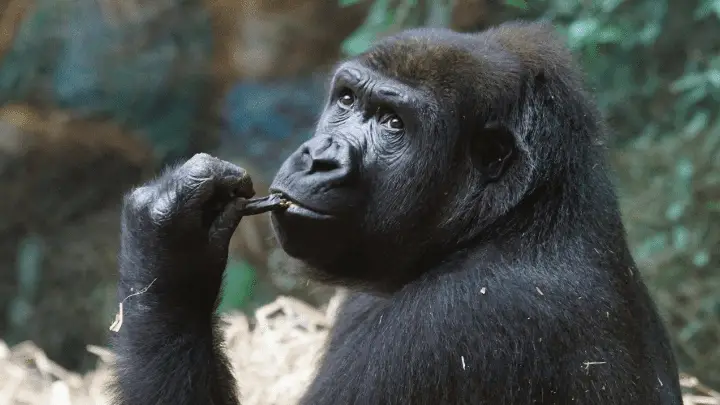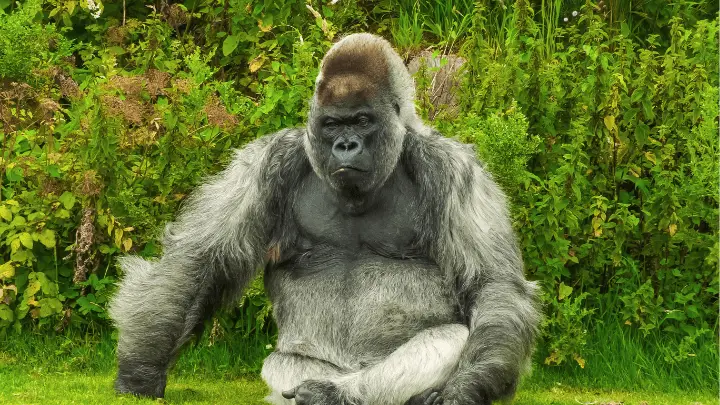Ah, the Gorilla. The mighty King of the Jungle. For centuries we have marveled at their sheer size and strength, yet how much do we know about these amazing creatures? Are gorillas herbivores, omnivores or carnivores?
Surprisingly, the answer has a lot to do with the environment in which they live – and it may surprise you. In this blog post, you will learn about gorilla diets and why they can be considered herbivores, carnivores, and omnivores.
Read on to learn more about the eating habits of our closest living relatives in the animal kingdom.
The Gorilla’s Diet

What do gorillas eat in the wild?
Gorillas are fascinating creatures of the wild, with a diet that is just as unique as they are. These majestic primates spend their time foraging for various plants throughout their African habitats, such as fruits, leaves, shoots, stems, seeds, flowers, and bark.
They also occasionally snack on termites and insects while spending around 30% of their day searching for food. Adult gorillas have even been known to feed on small mammals, such as rodents, on special occasions.
Through careful observation and study, it’s clear that gorillas are incredibly adaptable eaters.
Nutritional requirements of gorillas
Eating an abundance of foliage, gorillas make their mark on the jungles in which they roam. With nutrition at the backbone of their diet, these powerful primates feast on herbs, vines, and leaves – making up 68% of each meal.
Aside from stems, pith and epithelium from roots, bark, flowers, fruits, and roots add another 25%, 2.5%, and 1.4%, respectively.
Each prized bite plays a huge role in helping gorillas keep up with their strength and vitality – key for protecting their families, exploring the jungle, and finding enough food to share.
Comparison of gorilla diet to other primates
Gorillas may be known as fearsome beasts, but their diet is surprisingly gentle. Compared to other primates, gorillas eat significantly less meat and, instead, base most of their diet on plant matter like fruits and leaves.
They are also very selective about what kind of plants they eat; for example, gorillas in some parts of Africa may only consume certain varieties of bamboo.
This gives them a unique flavor that’s both delicious and gentle on the environment. It’s a diet full of flavor and diversity – and it’s also good for the planet.
Are Gorillas Herbivores, Omnivores Or Carnivores?

Gorillas are primarily herbivorous creatures, meaning they feed primarily on plants, such as fruits, leaves, and stems. However, they are also considered omnivores, meaning they eat some insects and small animals, such as eggs and larvae.
Therefore, gorillas can be categorized as both herbivores and omnivores. While gorillas are known for their powerful jaws and long, sharp claws, they rarely use them for hunting and prefer a plant-based diet.
Even when they eat meat, it is usually in small amounts and infrequently. Overall, gorillas are primarily herbivorous but will supplement their diet with occasional insect or animal matter. As such, gorillas can best be classified as omnivores.
Reasons Why Gorillas Are Herbivores
1. Nutrition: Gorillas are herbivores because they are best suited to digesting plants and plant-based foods, providing them with the necessary nutrients for survival.
2. Low risk of disease: A diet rich in plant-based foods is also beneficial to gorillas as it helps protect them against certain diseases caused by animal protein consumption. By avoiding animal proteins, gorillas can avoid contracting illnesses such as salmonella or E. coli, found in some animal proteins.
3. Optimal digestive system: Gorillas’ digestive systems are designed to digest mainly plant-based foods. In addition, gorillas have longer intestines than carnivores, allowing them to digest more complex carbohydrates from plants that can give them more energy and nutrition.
4. Dental Structure: Gorillas’ teeth are also adapted for a diet of mostly plants. Unlike many other primates and carnivorous animals, gorillas have flat molars. This enables them to grind their food more efficiently and reduce wear on their teeth from crunching hard nuts and seeds.
5. Natural habitat: Gorillas’ natural habitat also influences their diet. Living in the tropical forests of Africa, gorillas have access to abundant fresh fruits, vegetables, nuts, and leaves year-round.
This means they don’t have to rely on animal protein to survive; they can get all the nutrients they need from plants.
Reasons Why Gorillas Can Be Omnivores
1. Adaptability: Gorillas have adapted to their environment and can survive by consuming plants and animals. This flexibility in the diet has allowed gorillas to thrive in various habitats.
2. Varied Diet: Gorillas have a varied diet that includes leaves, stems, bark, flowers, fruit, insects, eggs, small mammals, and other invertebrates. This gives them the full range of nutrients they need to stay healthy.
3. Nutrient Sources: Gorillas receive protein, carbohydrates, fats, vitamins, and minerals from both animal sources and plants. This ensures they have a balanced and nutritious diet.
4. Availability: Food sources like fruits and insects are abundant throughout gorilla habitats, making them easy to acquire without traveling far. Additionally, gorillas have been observed eating carrion or hunting small animals when other food sources are scarce.
5. Social Nature: Gorillas tend to live in social groups, which helps them acquire food more easily. By working together, they can cover more ground in search of food and get more of it faster.
Additionally, gorillas groom each other, strengthening social bonds and allowing them to feed on parasites living on each other’s fur.
Reasons Why Gorillas Can Be Carnivores
1. Gorillas have a long history of being predators – Gorillas are considered to be the most primitive of the great apes, and they’ve been around for millions of years.
In fact, gorillas are thought to have evolved from a common ancestor of chimpanzees and humans, and their diet has likely remained similar over time.
2. Gorillas have canine teeth – Gorillas have sharp canine teeth, an adaptation for meat-eating and self-defense.
3. Gorillas are physically capable of eating meat – Gorillas have powerful jaws and sharp teeth, which allow them to hunt and consume prey.
FAQs
Can gorillas survive on a purely vegetarian diet?
Yes, gorillas can survive and thrive on a vegetarian diet. Their digestive system is adapted to extract nutrients from plant-based foods efficiently. In addition, they have evolved to consume a variety of plant species to meet their nutritional needs.
Do gorillas hunt for food like carnivores do?
No, gorillas do not hunt for food like carnivores. While they may occasionally consume insects or small animals, these are not a significant part of their diet.
How often do gorillas give birth?
With gestation periods lasting eight and a half months, female gorillas give birth only once every four to six years.
What threats do gorillas face?
Despite their might and majesty, gorillas face various threats that imperil their existence, from deforestation to poaching and disease.
Conclusion: Are Gorillas Herbivores, Omnivores Or Carnivores?
This has been an interesting exploration of whether gorillas are herbivores, omnivores, or carnivores. When looking at gorillas’ diet, it’s clear they are primarily herbivores.
However, they can also be considered “opportunistic omnivores,” meaning they will eat whatever is available – including insects, snails, and other small animals.
Most of their diet is still vegetation, but this versatility gives gorillas an edge in the wild. When researching gorillas’ diets, there were two main takeaways:
- Gorillas are primarily vegetarian and
- They have the potential to become omnivorous.
In a world where resources are limited and competition is high, it seems that having the ability to eat various foods gives these primates an edge. This has undoubtedly helped them survive and thrive over the centuries.
Learn more about animals by exploring the animal section.
Thanks for reading.

